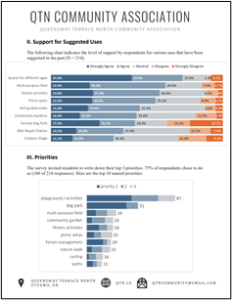
A draft Parks and Recreation Master Plan has been developed to accompany the new Official Plan. It updates city-wide goals for parkland and recreational facilities as Ottawa grows, but it falls short in dealing with intensification, the central issue facing Ottawa and QTN.
As an example, the current standard of one recreational complex for every 44,300 residents will change to one for every 50,000 residents with a recommendation to add one new facility in the next twenty years – on the other side of the city. Children, it says, should have access to a playground within a 5 to 10 minute walk. It sets standards for parkland and 22 different kinds of recreational facilities. If you are involved in sports, you may want to check what the plan says about your sport (PDF; City of Ottawa). Some QTN residents will be interested in plans to develop strategies for pickleball and skateboarding; both of these were named in the QTN survey as areas of interest.
The plan is oriented toward provincial policies and designed to provide a basis for legally requiring the dedication of parkland or cash for parks when new major developments are approved. While that is important, equally important is clarity about the relationship between the proposed forms of intensification and the provision of space for recreation. The draft plan lacks a vision that could galvanize public support for forms of intensification that improve neighborhoods. It does nothing to address the following key questions raised by QTN and other communities.
Lack of Neighborhood Level Planning
The plan includes no mechanisms to link city-wide targets with neighborhood park plans. While it recognizes the importance of recreational activity for health, it doesn’t translate that into a neighborhood-based approach to parks and recreation. It explicitly states that the city-wide guidelines do not apply to any particular neighborhood.
This approach leaves QTN and some other neighborhoods at the end of long lists of demands for repair or upgrading facilities, without hope of seeing what seem like basics for a growing population – like play structures for all ages, one of the priorities named by respondents in the QTN survey of park uses. While we welcome the replacement of one play structure in 2024, many children will be grown up before they have a playground that fosters their full development. Our long-running fight for community use of the Frank Ryan Fieldhouse still has no end in sight.
Inequitable treatment of different forms of intensification
The number of additional park users in QTN as a result of four-plexes replacing single family homes is more than equivalent to adding an apartment of 10 units with 5 or more stories. A large apartment building would trigger funding for parks, but many four-plexes or walk-ups do not. The much vaunted “613 Flats,” a proposed form of intensification for QTN, will not result in additional funds for playgrounds or park space, while it will dramatically reduce the amount of play space and green space around and between houses.
The current policy results in inequitable treatment between neighborhoods. While the plan names some of these issues in the section on funding, it does not propose any solutions. Part of the problem is provincial policy. Part of it is the lack of a clear and consistent approach to community services related to intensification. The City of Ottawa could work with community associations to change provincial policies if there was a clear policy about community benefits, to replace the current jockeying for cash-in-lieu payments associated with large development projects. The current draft lacks the vision we need to make intensification work for everyone.
Time lag
The priorities identified in the QTN Use of Parks Survey are reasonable and consistent with the goal of 15-Minute Neighborhoods. I see nothing in this draft city plan for parks and recreation that will address the long lag time between identified needs and improvements in the provision and maintenance of local recreational infrastructure and activities. QTN Community Association will continue to advocate for the priorities named by residents. We can organize some activities ourselves. We also need change in City policies to give higher priority to local parks and recreation.

